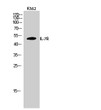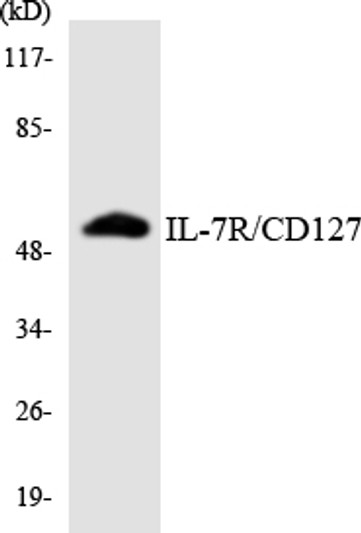| Host: | Rabbit |
| Applications: | WB/ELISA |
| Reactivity: | Human/Mouse/Monkey |
| Note: | STRICTLY FOR FURTHER SCIENTIFIC RESEARCH USE ONLY (RUO). MUST NOT TO BE USED IN DIAGNOSTIC OR THERAPEUTIC APPLICATIONS. |
| Short Description : | Rabbit polyclonal antibody anti-Interleukin-7 receptor subunit alpha (410-459 aa) is suitable for use in Western Blot and ELISA research applications. |
| Clonality : | Polyclonal |
| Conjugation: | Unconjugated |
| Isotype: | IgG |
| Formulation: | Liquid in PBS containing 50% Glycerol, 0.5% BSA and 0.02% Sodium Azide. |
| Purification: | The antibody was affinity-purified from rabbit antiserum by affinity-chromatography using epitope-specific immunogen. |
| Concentration: | 1 mg/mL |
| Dilution Range: | WB 1:500-1:2000ELISA 1:40000 |
| Storage Instruction: | Store at-20°C for up to 1 year from the date of receipt, and avoid repeat freeze-thaw cycles. |
| Gene Symbol: | IL7R |
| Gene ID: | 3575 |
| Uniprot ID: | IL7RA_HUMAN |
| Immunogen Region: | 410-459 aa |
| Specificity: | IL-7R Polyclonal Antibody detects endogenous levels of IL-7R protein. |
| Immunogen: | The antiserum was produced against synthesized peptide derived from the human IL-7R/CD127 at the amino acid range 410-459 |
| Function | Receptor for interleukin-7. Also acts as a receptor for thymic stromal lymphopoietin (TSLP). |
| Protein Name | Interleukin-7 Receptor Subunit AlphaIl-7 Receptor Subunit AlphaIl-7r Subunit AlphaIl-7r-AlphaIl-7raCdw127Cd Antigen Cd127 |
| Database Links | Reactome: R-HSA-1266695Reactome: R-HSA-8856825Reactome: R-HSA-8856828 |
| Cellular Localisation | Isoform 1: Cell MembraneSingle-Pass Type I Membrane ProteinIsoform 3: Cell MembraneIsoform 4: Secreted |
| Alternative Antibody Names | Anti-Interleukin-7 Receptor Subunit Alpha antibodyAnti-Il-7 Receptor Subunit Alpha antibodyAnti-Il-7r Subunit Alpha antibodyAnti-Il-7r-Alpha antibodyAnti-Il-7ra antibodyAnti-Cdw127 antibodyAnti-Cd Antigen Cd127 antibodyAnti-IL7R antibody |
Information sourced from Uniprot.org












